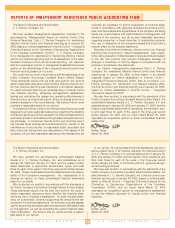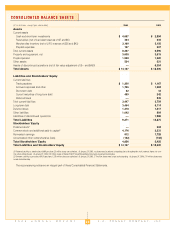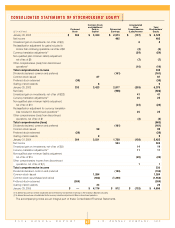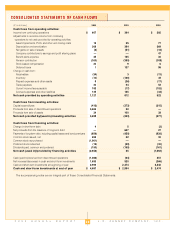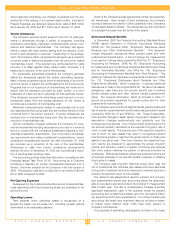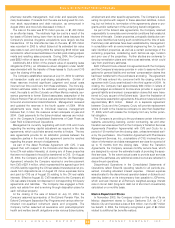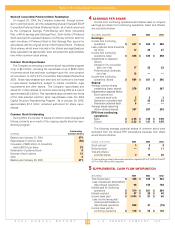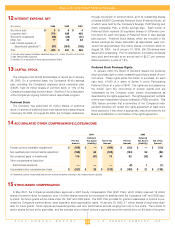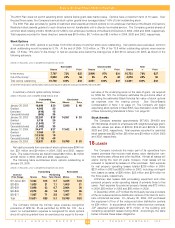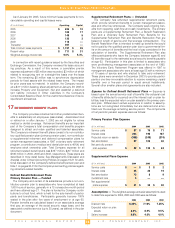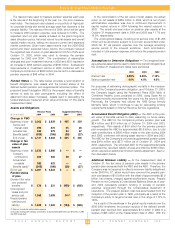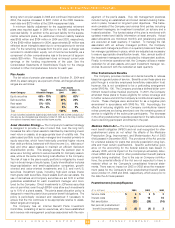JCPenney 2004 Annual Report Download - page 35
Download and view the complete annual report
Please find page 35 of the 2004 JCPenney annual report below. You can navigate through the pages in the report by either clicking on the pages listed below, or by using the keyword search tool below to find specific information within the annual report.
J.C. PENNEY COMPANY, INC.2 004 ANNUAL REPORT
Notes to the Consolidated Financial Statements
33
impairment loss is calculated by subtracting the fair value of the
assets from the reported value of the assets. Management esti-
mates fair value based on a projected discounted cash flow
method using a discount rate that is considered to be commensu-
rate with the risk inherent in the Company’s current business
model. Additional factors are taken into consideration, such as
local market conditions, operating environment, mall performance
and other trends. SFAS No. 144 requires that a long-lived asset to
be abandoned be considered held and used until it is disposed of.
For a long-lived asset to be disposed of by sale or otherwise, the
unit of accounting is the group (disposal group) that represents
assets to be disposed of together as a group in a single transac-
tion and liabilities directly associated with these assets that will be
transferred in the transaction. SFAS No. 144 establishes six crite-
ria that must be met before a long-lived asset may be classified as
“held for sale.” Assets that meet those criteria are no longer depre-
ciated and are measured at the lower of carrying amount at the
date the asset initially is classified as held for sale or its fair value
less costs to sell. See Note 2 for discussion of the presentation of
Eckerd net assets as held for sale and the adjustment recorded as
of year-end 2003 to reduce the Company’s investment in Eckerd to
the fair value less costs to sell.
Based on management’s ongoing review of the performance of
its portfolio of stores and other facilities, impairment losses totaling
$12 million, $26 million and $47 million in 2004, 2003 and 2002,
respectively, were recorded for underperforming department
stores and underutilized Catalog and other facilities. These
charges are reflected in Real Estate and Other Expense/(Income),
which is a component of Income from Continuing Operations in the
accompanying Consolidated Statements of Operations. See fur-
ther discussion in Note 18.
Exit or Disposal Activity Costs
In accordance with SFAS No. 146, “Accounting for Costs
Associated with Exit or Disposal Activities,” costs associated with
exit or disposal activities are recorded at their fair values when a
liability has been incurred. Reserves are established at the time of
closure for the present value of any remaining operating lease obli-
gations (PVOL), net of estimated sublease income, and at the point
of decision for severance and other exit costs. Since the Company
has an established program for termination benefits upon the clos-
ing of a facility, termination benefits paid under the existing pro-
gram are considered part of an ongoing benefit arrangement, and
accounted for under SFAS No. 112, “Employers’ Accounting for
Postemployment Benefits,” and recorded when payment of the
benefits is considered probable and reasonably estimable.
Foreign Currency Translation
Financial statements of subsidiaries outside the United States
are measured using the local currency as the functional currency.
Assets and liabilities for these subsidiaries are translated into U.S.
dollars at the exchange rates in effect at the balance sheet date,
while revenues and expenses are translated using average curren-
cy rates during the reporting period. Adjustments from such trans-
lations are accumulated in the equity section of the Consolidated
Balance Sheets under Accumulated Other Comprehensive (Loss).
Effect of New Accounting Standards
On May 19, 2004, the FASB issued FASB Staff Position (FSP)
SFAS No. 106-2, “Accounting and Disclosure Requirements
Related to the Medicare Prescription Drug, Improvement and
Modernization Act of 2003.” The referenced legislation (the Act)
was passed in December 2003, and provides for a federal subsidy
to employers that offer retiree prescription drug benefits that are at
least actuarially equivalent to those offered under the government
sponsored Medicare Part D. While the provisions of FSP SFAS No.
106-2 were effective in the Company’s third quarter of 2004, final
regulations that define actuarial equivalency were not issued until
January 2005. As a result, the disclosures included in Note 17 do
not reflect the potential effects of the Act, which, due largely to the
cap on Company contributions, are not expected to have a materi-
al effect on the Company’s consolidated financial statements.
In November 2004, the FASB issued SFAS No. 151, “Inventory
Costs – An Amendment of ARB No. 43, Chapter 4.” SFAS No. 151
amends the guidance in ARB No. 43, Chapter 4, “Inventory Pricing,”
to clarify the accounting for abnormal amounts of idle facility
expense, freight, handling costs and wasted material (spoilage).
SFAS No. 151 is effective for fiscal years beginning after June 15,
2005 and will be early-adopted by the Company in the first quarter of
fiscal 2005. The Company does not expect SFAS No. 151 to have a
material impact on the Company’s consolidated financial statements.
In December 2004, the FASB issued SFAS No. 123 (revised)
(SFAS No. 123R), "Share-Based Payment." SFAS No. 123R will
eliminate the ability to account for share-based compensation
transactions using APB No. 25 and will require instead that com-
pensation expense be recognized based on the fair value of the
award on the date of grant. Additional footnote disclosures will also
be required. While the Company is not required to adopt SFAS No.
123R until the third quarter of 2005, it has elected to early-adopt the
statement effective January 30, 2005, using the modified prospec-
tive method of application. Under this method, in addition to reflect-
ing compensation expense for new share-based awards, expense
will also be recognized to reflect the remaining vesting period of
awards that had been included in pro-forma disclosures in prior
periods. The Company will not adjust prior year financial state-
ments under the optional modified retrospective method of
adoption.
2DISCONTINUED OPERATIONS
Eckerd Drugstores
During the fourth quarter of 2003, the Company’s Board of
Directors authorized Company management to sell the Eckerd
Drugstore operations. Having met the criteria of SFAS No. 144,
“Accounting for the Impairment or Disposal of Long-Lived Assets,”
Eckerd’s net assets were classified as “held for sale” and its results
of operations and financial position presented as a discontinued
operation as of year-end 2003, with prior periods reclassified
accordingly.
On July 31, 2004, the Company closed on the sale of Eckerd for
atotal of approximately $4.7 billion in gross cash proceeds that
included a $209 million adjustment for the estimated increase in
Eckerd’s working capital from January 31, 2004 to July 31, 2004.
After deducting taxes, fees and other transaction costs, and esti-
mated post-closing adjustments, the ultimate net cash proceeds
from the sale are expected to total approximately $3.5 billion. The
Jean Coutu Group (PJC) Inc. (Coutu) acquired Eckerd drugstores
and support facilities located in 13 Northeast and Mid-Atlantic
states, as well as the Eckerd Home Office located in Florida. CVS
Corporation and CVS Pharmacy, Inc. (collectively, CVS) acquired
Eckerd drugstores and support facilities located in the remaining
Southern states, principally Florida and Texas, as well as Eckerd’s



